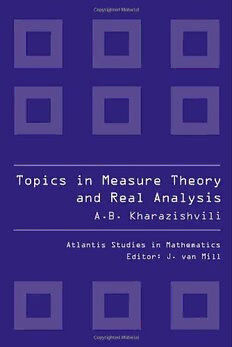Table Of ContentATLANTIS STUDIES IN MATHEMATICS
VOLUME 2
SERIES EDITOR: J. VAN MILL
Atlantis Studies in Mathematics
Series Editor:
J. vanMill,VU UniversityAmsterdam,Amsterdam,theNetherlands
(ISSN:1875-7634)
Aimsandscopeoftheseries
Theseries‘AtlantisStudiesinMathematics’(ASM)publishesmonographsofhighquality
inallareasofmathematics. Bothresearchmonographsandbooksofanexpositorynature
arewelcome.
Allbooksinthisseriesareco-publishedwithWorldScientific.
Formoreinformationonthisseriesandourotherbookseries,pleasevisitourwebsiteat:
www.atlantis-press.com/publications/books
AMSTERDAM –PARIS
(cid:2)c ATLANTISPRESS/WORLDSCIENTIFIC
Topics in Measure Theory
and Real Analysis
Alexander B. Kharazishvili
A.Razmadze MathematicalInstitute
Tbilisi
RepublicofGeorgia
AMSTERDAM –PARIS
AtlantisPress
29,avenueLaumie`re
75019Paris,France
ForinformationonallAtlantisPresspublications,visitourwebsiteat:
www.atlantis-press.com
Copyright
This book, or any parts thereof, may not be reproducedfor commercial purposes in any
formorbyanymeans,electronicormechanical,includingphotocopying,recordingorany
informationstorageandretrievalsystemknownortobeinvented,withoutpriorpermission
fromthePublisher.
AtlantisStudiesinMathematics
Volume1:TopologicalGroupsandRelatedStructures-A.Arhangel’skii,M.Tkachenko
ISBN:978-90-78677-20-8 e-ISBN:978-94-91216-36-7
ISSN:1875-7634
(cid:2)c 2009ATLANTISPRESS/WORLDSCIENTIFIC
Preface
This book is concerned with questions of classical measure theory and related topics of
realanalysis. Atthebeginning,itshouldbesaidthatthechoiceofmaterialincludedinthe
presentbookwascompletelydictatedbyresearchinterestsandpreferencesoftheauthor.
Nevertheless, we hope that this material will be of interest to a wide audience of mathe-
maticiansand, primarily,to those who are workingin variousbranchesof modernmath-
ematicalanalysis,probabilitytheory,thetheoryofstochasticprocesses,generaltopology,
andfunctionalanalysis. Inaddition,wetouchupondeepset-theoreticalaspectsofthetop-
icsdiscussedinthebook;consequently,set-theoristsmaydetectnontrivialitemsofinterest
to them and find out new applications of set-theoretical methods to various problems of
measuretheoryandrealanalysis. Itshouldalsobenotedthatquestionstreatedinthisbook
are related to material found in the following three monographspreviouslypublished by
theauthor.
1) TransformationGroupsand InvariantMeasures, World Scientific Publ. Co., London-
Singapore,1998.
2) NonmeasurableSetsandFunctions,North-HollandMathematicsStudies,Elsevier,Am-
sterdam,2004.
3) StrangeFunctionsinRealAnalysis,2ndedition,ChapmanandHall/CRC,BocaRaton,
2006.
For the convenienceof our readers, we will first, briefly and schematically, describe the
scopeofthisbook.
In Chapter 1, we considerthe generalproblemof extendingpartialreal-valuedfunctions
which, undoubtedly,is oneof the mostimportantproblemsin all of contemporarymath-
ematicsandwhichdeservestobediscussedthoroughly. Sincethesatisfactorysolutionto
thistaskrequiresaseparatemonograph,wecertainlydonotintendonenteringdeeplyinto
v
vi TopicsinMeasureTheoryandRealAnalysis
various aspects of the problem of extending partial functions, but rather we restrict our-
selvestoseveralexamplesthatareimportantforrealanalysisandclassicalmeasuretheory
andvividlyshowthefundamentalcharacterofthisproblem. Thecorrespondingexamples
aregiveninChapter1andillustratedifferentapproachesandappropriateresearchmethods.
Noticethatsomeoftheexamplespresentedinthischapterareconsideredinmoredetails
insubsequentsectionsofthebook.
Chapter 2 is devoted to a special, but very important, case of the extension problem for
real-valuedpartialfunctions. Namely,wediscussthereinseveralvariantsoftheso-called
measureextensionproblemandwepayourattentiontopurelyset-theoretical,algebraicand
topologicalaspectsofthisproblem.Inthesamechapter,theclassicalmethodofextending
measures, developed by Marczewski (see [234] and [235]), is presented. Also, a useful
theoremis provedwhich enablesus to extend anyσ-finite measure μon a base set E to
ameasure μ(cid:3) onthesameE,suchthatallmembersofagivenfamilyofpairwisedisjoint
subsets of E become μ(cid:3)-measurable (see [1] and [13]). This theorem is then repeatedly
appliedinfurthersectionsofthebook.
In Chapters 3 and 4 we primarily deal with those measures on E which are invariant or
quasi-invariantwithrespecttoacertaingroupoftransformationsofE. Itiswidelyknown
thatinvariantandquasi-invariantmeasuresplayacentralroleinthetheoryoftopological
groups, functionalanalysis, and the theoryof dynamicalsystems. We discuss somegen-
eral propertiesof invariantand quasi-invariantmeasuresthat are helpfulin variousfields
of mathematics. First of all, we mean the existence and uniqueness properties of such
measures. Theproblemoftheexistenceanduniquenessofaninvariantmeasurenaturally
arisesforalocallycompacttopologicalgroupendowedwiththegroupofallitsleft(right)
translations. In this way, we come to the well-knownHaar measure. Thetheoryof Haar
measureisthoroughlycoveredinmanytext-booksandmonographs(see,forinstance,[80],
[83],[182],[202]),so we leaveaside themainaspectsofthistheory. Butwe presentthe
classical Bogoliubov-Krylovtheorem on the existence of a dynamical system for a one-
parameter group of homeomorphismsof a compact metric space E. More precisely, we
formulateandproveasignificantgeneralizationoftheBogoliubov-Krylovstatement: the
so-calledfixed-pointtheoremofMarkovandKakutani([93],[168])forasolvablegroupof
affinecontinuoustransformationsofanonemptycompactconvexsetinaHausdorfftopo-
logicalvectorspace.Inthesamechapters,wedistinguishthefollowingtwosituations:the
casewhenagiventopologicalspaceEislocallycompactandthecasewhenEisnotlocally
compact. Thelattercaseinvolvestheclassofallinfinite-dimensionalHausdorfftopolog-
Preface vii
ical vector spaces for which the problem of the existence of a nonzero σ-finite invariant
(respectively,quasi-invariant)Borelmeasureneedsaspecificformulation.Someresultsin
thisdirectionarepresentedwithnecessarycomments.
Chapter 5 is concernedwith measurabilitypropertiesof real-valuedfunctionsdefined on
anabstractspaceE,whenacertainclassMofmeasuresonE isdetermined.Weintroduce
threenotionsforagivenfunction f actingfromE intothereallineR. Namely, f maybe
(a) absolutelynonmeasurablewithrespecttoM,
(b) relativelymeasurablewithrespecttoM,
(c) absolutely(oruniversally)measurablewithrespecttoM.
Weexaminethesenotionsandshowtheircloseconnectionswithsomeclassicalconstruc-
tionsinmeasuretheory.Itshouldbepointedoutthatthestandardconceptofmeasurability
of f withrespecttoafixedmeasureμonE isaparticularcaseofthenotions(b)and(c).
Inthiscase,theroleofMisplayedbytheone-elementclass{μ}.
InChapter6wediscuss,againfromthemeasure-theoreticalpointofview,someproperties
of the so-called step-functions. Since step-functionsare rather simple representatives of
the class ofall functions(namely,the rangeofa step-functionis atmostcountable),it is
reasonabletoconsidertheminconnectionwiththemeasureextensionproblem.Itturnsout
thatthebehaviorofsuchfunctionsisessentiallydifferentinthecaseofordinarymeasures
andinthecaseofinvariant(quasi-invariant)measures.
InChapter7,weintroduceandinvestigatetheclassofalmostmeasurablereal-valuedfunc-
tions on R. This class properly contains the class of all Lebesgue measurable functions
on R and has certain interesting features. A characterizationof almostmeasurable func-
tions is given and it is shown that any almost measurable function becomes measurable
withrespecttoasuitableextensionofthestandardLebesguemeasureλonR.
Chapter 8 focuses on several importantfacts from general topology. In particular, Kura-
towski’stheorem(see, forinstance, [58],[101],[149])onclosed projectionsis presented
with some of its applicationsamongwhich we especially examinethe existence of a co-
meager set of continuousnowhere differentiable functions in the classical Banach space
C[0,1]. Also, we prove a deep theorem on the existence of Borel selectors for certain
partitionsofaPolishtopologicalspace,whichisessentiallyusedinthesequel.
In Chapter 9 the concept of the weak transitivity of an invariant measure is considered
and its influenceon the existence of nonmeasurablesets is underlined. Here it is vividly
shownthatsomeoldideasofMinkowski[173]whichweresuccessfullyappliedbyhimin
viii TopicsinMeasureTheoryandRealAnalysis
convexgeometryandgeometricnumbertheory,arealsohelpfulinconstructionsofvarious
paradoxical(e.g., nonmeasurable) sets. Actually, Minkowski had at hand all the needed
toolstoprovetheexistenceofthosesubsetsoftheEuclideanspaceRn (n(cid:2)1),whichare
nonmeasurablewithrespecttotheclassicalLebesguemeasureλ onRn.
n
Chapter10coversbadsubgroupsofanuncountablesolvablegroup(G,·). Theterm”bad”,
of course, means the nonmeasurabilityof a subgroupwith respectto a given nonzeroσ-
finiteinvariant(quasi-invariant)measureμonG. We establishtheexistenceofsuchsub-
groups of G and, moreover, show that some of them can be applied to obtain invariant
(quasi-invariant)extensionsof μ. So, despitetheir badstructuralproperties, certainnon-
measurablesubgroupsofGhaveapositivesidefromtheview-pointofthegeneralmeasure
extensionproblem.
Thenexttwochapters(i.e.,Chapters11-12)aredevotedtothestructureofalgebraicsums
of small (in a certain sense) subsets of a given uncountable commutative group (G,+).
RecallthatthefirstdeepresultinthisdirectionwasobtainedbySierpin´skiinhisclassical
work[219]wherehestatedthattherearetwoLebesguemeasurezerosubsetsoftherealline
R,whosealgebraic(i.e.,Minkowski’s)sumisnotLebesguemeasurable. Letusstressthat
in[219]thetechniqueofHamelbaseswasheavilyexploitedandinthesequelsuchanap-
proachbecameapowerfulresearchtoolforfurtherinvestigations.WedevelopSierpin´ski’s
above-mentionedresultandgeneralizeitintwodirections.Namely,weconsiderthepurely
algebraicaspectoftheproblemanditstopologicalaspectaswell. Thedifferencebetween
these two aspects is primarily caused by two distinct concepts of “smallness” of subsets
ofR.
In Chapters 13 and 14 we turn our attention to Sierpin´ski-Zygmundfunctions [225] and
study them from the point of view of the measure extension problem. It is well known
that the restriction of a Sierpin´ski-Zygmund function to any subset of R of cardinality
continuumisdiscontinuous.ThiscircumstancedirectlyimpliesthataSierpin´ski-Zygmund
function is nonmeasurable in the Lebesgue sense and, moreover, is nonmeasurable with
respecttothecompletionofanarbitrarynonzeroσ-finitediffusedBorelmeasureonR. In
addition,noSierpin´ski-ZygmundfunctionhastheBaireproperty.
WegivetwonewconstructionsofSierpin´ski-Zygmundfunctions.
(1) TheconstructionofaSierpin´ski-Zygmundfunctionwhichisabsolutelynonmeasurable
with respectto theclassofallnonzeroσ-finitediffusedmeasuresonR. (Noticethat
thisresultneedssomeextraset-theoreticalaxioms.)
Preface ix
(2) TheconstructionofaSierpin´ski-Zygmundfunctionwhichisrelativelymeasurablewith
respectto the class of alltranslation-invariantextensionsof the Lebesguemeasureλ
onR. (Thisresultdoesnotneedanyadditionalset-theoreticalhypotheses.)
Chapters15-17aresimilartoeachotherinthesensethatthemaintopicsdiscussedtherein
areconnectedwithdifferentconstructionsofnonseparableextensionsofσ-finitemeasures.
Amongtheresultspresentedinthesechapters,letusespeciallymention:
(i) the construction(assumingtheContinuumHypothesis)ofa nonseparableextension
oftheLebesguemeasurewithoutproducingnewnull-sets;
(ii) theconstruction(alsoundersomeadditionalset-theoreticalaxioms)ofnonseparable
invariantextensionsof σ-finite invariantmeasuresby using their nontrivialergodic
components;
(iii) theconstruction(assumingagaintheContinuumHypothesis)ofanonseparablenon-
atomicleftinvariantσ-finitemeasureonanyuncountablesolvablegroup.
In Chapter 18, we consider universally measurable additive functionals. The universal
measurabilityistreatedhereinageneralizedsense,namely,areal-valuedfunctional f on
a HilbertspaceE is universallymeasurableif and onlyif for anyσ-finite Borelmeasure
μgiven on E, there exists an extension μ(cid:3) of μsuch that f becomes measurable with
respect to μ(cid:3). It is established that there are universally measurable additive functionals
whichareeverywherediscontinuous. Thisresultmayberegardedasacounter-versionto
thewell-knownstatement(see,e.g.,[97],[153],[154]),accordingtowhichanyuniversally
measurable(intheusualsense)additivefunctionalonE isnecessarilycontinuous.
Chapter 19 is devoted to certain strange subsets of the Euclidean plane R2. We discuss
various properties of these paradoxical sets from the measure-theoretical view-point. In
particular,asubsetZ ofR2 isconstructedwhichisalmostinvariantunderthegroupofall
translationsofR2,isλ-thick(whereλ standsforthetwo-dimensionalLebesguemeasure
2 2
onR2)and,inaddition,hasthepropertythatforeachstraightlinel inR2,theintersection
l∩Z isofcardinalitystrictlylessthanthecardinalityofthecontinuum. Byusingthisset
Z, we definetranslation-invariantextensionsofλ forwhichnoanalogueofthe classical
2
Fubinitheoremcanbevalid.
ThefinalchapterisconnectedwithcertainrestrictionsoffunctionsactingfromRintoR.
Thefirstexamplesofthoserestrictionsofmeasurablefunctions,whicharedefinedonsuf-
ficientlylargesubsetsofRandhavevariousniceproperties,weregiveninwidelyknown

